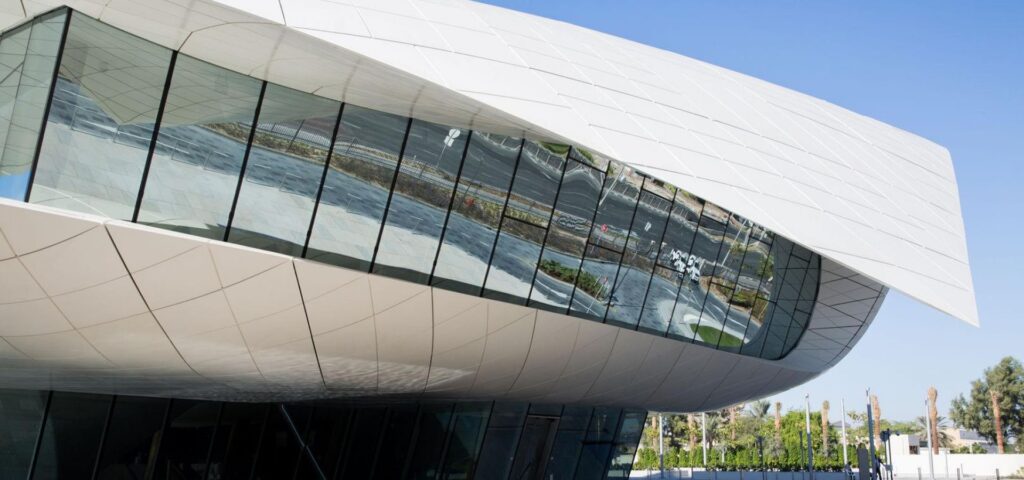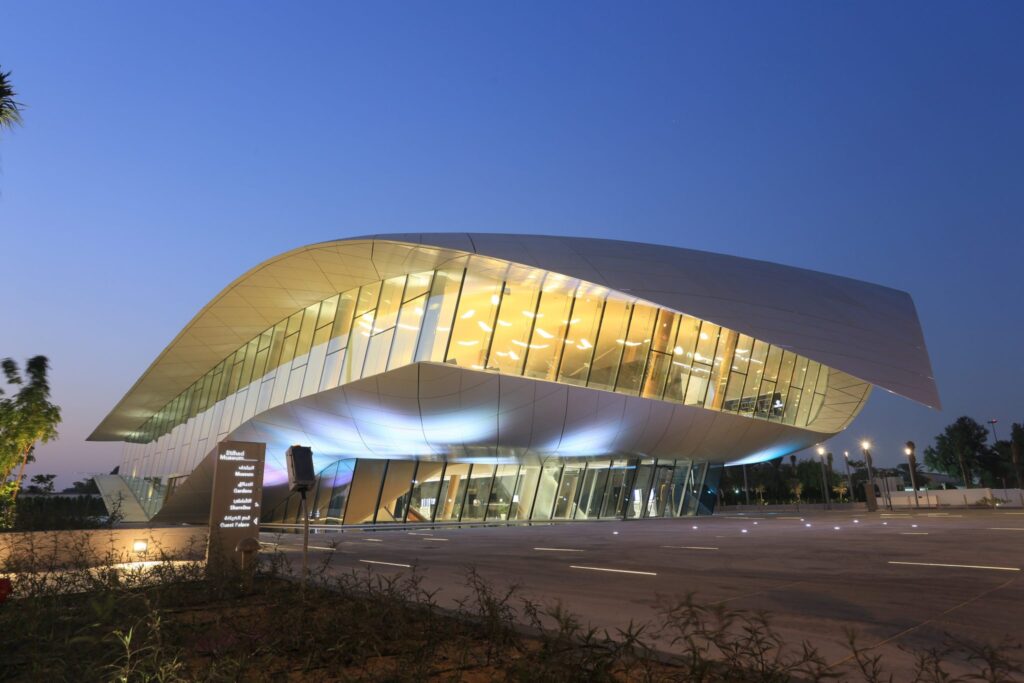The UAE is rich in culture; if you want to learn more about it, the Etihad Museum in Dubai is a great place to visit. A 21st-century ode to the past, the modern museum spans over 25,000 square meters. It includes interactive exhibits that tell how this country came to be and photos of the founding fathers. If you intend to visit soon, here is a complete guide on the ticket prices, venue, pavilions, and all other related information about the Etihad Museum. Your tour guide will brief you about the Etihad Museum during your Dubai city tour.
Location Of Etihad Museum
Do many people ask why the Etihad Museum’s location is critical? The answer is that Etihad Museum is near the Dubai Waterfront Union Historic Building. The Union Museum celebrates the 1971 signing of an Arab Emirates document celebrating its rich culture and history. Most of the museum is underground, with permanent and temporary galleries, theatres, venues for events, and archival venues. A reflective pond and place are the site of a dramatic pavilion. Their wave-like parabola curves depict the parchment used as the basis for the unification agreement and its tapering golden columns representing the stalks on which the document was printed. There are many other attractive things to do in Dubai.
You can realize the recent past of the UAE at an important cultural site in Dubai. The Etihad Museum is situated in a splendid Jumeirah building with various interactive pavilions that allow visitors to experience the Al Bastakiya of the UAE. Visitors will learn how the nation evolved, especially from 1968 to 1974, using photographs, movies, and more. The distinctive curved white roof of the museum was influenced by the constitutional form, designed by Canadian Architects Moriyama and Teshima. It also has seven columns, symbolizing the types used to sign the contract.
About Etihad Museum

To optimize visitors’ experience, the essence of the museum’s programming as an immersive learning environment required easy flow. A multimedia display spanning the place and educational information are available to cultivate the site as an active historical and cultural campus. The plain, double-curved skin of the Etihad Pavilion is a highly sophisticated envelope and substructure montage. Innovations in steel superstructures and coating assembly were necessary to achieve the big cantilevers of a curving shell, which gave the impression of a floating paper piece. With the wide eastern entrance and the bent structural columns, a large structural eccentricity resulted in the primary glazed facade being part of the framework and shear. The single columns in structural glass make the world the first inclining glass fin façade.
Museum History
The Etihad Museum is partnered with the Roads and Transport Authority (RTA) and the Dubai Cultural and Art Authorities. The question is, When was the Etihad museum built? And Who built the Etihad Museum? It was opened on December 2, 2016, by the Sheik Mohammed during the 45th National Day celebrations. While the former is responsible for planning, construction, and production, the latter manages the site. It is a repository for film content, photos, artifacts, timelines, and interactive exhibits. The UAE flag marks the Etihad Museum over a 123-meter golden pole on Jumeirah Beach Lane. This panoply of originals focuses on historical milestones in the years leading to the unification of the United Arab Emirates.
Etihad Museum Layout

In the museum, the pavilion has a transparent material contrast – a pristine, white marble floor covering the entire room forms the Amphitheater steps that make it possible for school groups and workshops to be arranged in an intimate space meeting. Although the ribbed black marble is highly textured, it encloses the middle of the building and connects the visitors to the lower floor, housing an exhibition space. The pavilion visitors are carefully designed via the grand staircase and ramp underneath the grade, whose shapes represent the Arabic script’s sharp and flowing calligraphic lines.
The visitors flow through the museum, giving them a constant reference point as they traverse the large, permanent open gallery and supporting spaces that enclose them. The sculptured wood columns and the luster of the bronze type, which show the warmth of this lower slope, further emphasize the flow of movement by highlighting the white, billowing roof planes created by wind patterns on the desert sands.
Etihad Museum Timings and Contact
The Etihad Museum’s operating hours are from ten a.m. to eight a.m. every day. To get more details about the abovementioned information, you can contact the museum’s team at +971-4 515-5771 or e-mail them at etihad.museum@dubaiculture.ae.
How do I get to the Etihad Museum if you want to visit? The easiest way to get to this place is by car or taxi. There’s plenty of space in the parking lot of the Etihad Museum if you take your vehicle. The Al Yafaliya stop on the Dubai red metro line is the nearest underground station to the Museum of Jumeirah Etihad for those who travel by public transport.
Etihad Museum Exhibition

Etihad Museum provides a fascinating trip to the past through a historical chronology of events that led to the Union of the Emirates in 1971. The foremost curiosity is, what is inside the Etihad Museum? In the Etihad Museum, you are followed by some smaller exhibits on the voyage of the founders of the UAE and how the seven emirates were brought together. Here is a short overview of the displays and exhibits at each Etihad Museum. The answer is: Why are museums so important?
Founders
The magnificent gallery of all UAE Founding Fathers is the first major exhibition in this museum to which you will be invited. An interactive screen illustrates their biographies and a glass enclosing a number of their properties accompanies each photograph. This is a special exhibit in the Etihad Musée as people look at their own first-hand life through pictures and videos of the rulers that have never been seen before. The second half of the museum shows interesting special effects. The display explains the history of the Union and other significant events during the foundation of the UAE, utilizing photographs and music.
Interactive Map

Before the Union of the Seven Emirates plunged the world into tribal countries, visitors traveled through Section 1 and Section 2 of the museum. An interactive UAE map displays the country before the Federation of the Emirates. As they explore this map, visitors can also access informational videos and audio about important events in the UAE’s history.
Road to Unification
This is very informative but one of the most miniature displays in the museum. The interactive screen shows several agreements that have taken place with neighboring Arab countries and foreign states. As the name says, visitors can see any significant event in the foundation of the United Arab Emirates. The illustration of an irrigation canal details all of the events. This irrigation channel is divided into three parts chronologically, each with information on historical events such as the founding of the Trucial Council and more.
Change and Unification

Visitors will play a game in this exhibition. All they need to do is disclose the encrypted messages displayed on seven cubes aligned with the interactive screens in the space. Each cube is a unique topic and offers information and photos. This show should be discussed if we want to learn through a series of images and audio messages about the problems faced by the founding fathers before 1971.
Seeds of Unity
The next visitor to the show will be the Seeds of Peace at the Etihad Museum. This 3D visual page shows how Sheik Zayed bin Sultan Al Nahyan meets Sheik Rashid bin Saeed Al Maktoum, his fellow countryman and leader, in Sayh Al Madira. The technology employed here makes the two rulers appear in the room.
Constitution

Another impressive exhibit in the Etihad Museum is the exhibit of the Constitution of the USA signed by the Governors of Etihad. Copies of the constitution of the UAE in Arabic and English can be viewed here. The friendship agreement between the United Arab Emirates and the United Kingdom, signed on the same day by Sheik Zayed, declared that the United Arab Emirates Federation was also present. There is an open hall with interactive displays of educational materials that visitors can explore to learn more, such as the production of unified passports in the United African States. It also provides a synopsis of the Union – both past and future.
Etihad Museum Attractions
The museum has many other attractions and services and fantastic exhibits. The Union Building, Union Flag, and Guest Palace may be visited outside. The Etihad Museum in Dubai represents an essential piece of the history of the UAE in each of these attractions. The Union House is the birthplace of the United African States (UAE), and the Union Flag is where the founding governors met after the Treaty was concluded. Sheik Rashid Bin Saeed Al Maktoum’s Majlis is also located in the Guest Palace, his private office, and a 300-person restaurant.
Tips Before Visiting Etihad Museum?

Regarding the Etihad museum tickets, a reduced payment of 10AED can be paid by the 5–24. The museum is free of charge for children under five or disabled people. Remember to drop down on the 3rd floor by the Seven Sands Cafe and enjoy their delicious sweets. The hi-tech auditorium video provides a perfect way to gain insight into the Union’s past by interviewing critical individuals in detail. If you want to come here, you should plan a minimum of

